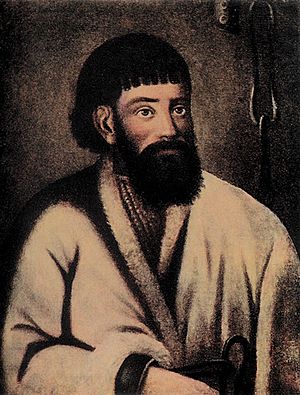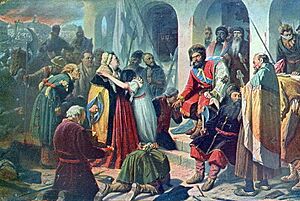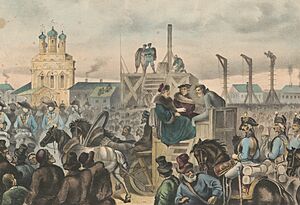Pugachev's Rebellion facts for kids
Quick facts for kids Pugachev's Rebellion |
|||||||
|---|---|---|---|---|---|---|---|
 |
|||||||
|
|||||||
| Belligerents | |||||||
• Imperial Russian Army |
• Ural Cossacks • Russian serfs • Old Believers • Bashkirs • Tatars • Chuvashs • Mari people • Mordvins (Erzyas and Mokshas) • Udmurts • Kazakhs • Kalmyks |
||||||
| Commanders and leaders | |||||||
| Catherine the Great Grigory Potemkin Petr Panin Alexander Suvorov Johann von Michelsohnen |
Yemelyan Pugachev Salawat Yulayev |
||||||
| Strength | |||||||
| 5,000+ men |
1773:
1774:
|
||||||
| Casualties and losses | |||||||
| 3,500 killed |
|
||||||
The Pugachev's Rebellion was a huge uprising that happened in the Russian Empire between 1773 and 1775. It's also known as the Peasants' War or Cossack Rebellion. This revolt was the biggest in a series of uprisings that took place after Catherine the Great became empress in 1762.
The rebellion started with Yemelyan Pugachev, a former army officer, and the Yaik Cossacks. They were unhappy with the government and the difficult lives of peasants. Pugachev claimed to be the late Tsar Peter III, who was Catherine's husband. He promised to end serfdom, which was a system where peasants were tied to the land and belonged to nobles. This made him a big challenge to Catherine's rule.
Many different groups joined the rebellion, including peasants, Cossacks, and religious groups called Old Believers. At one point, Pugachev's forces controlled a large area between the Volga River and the Ural Mountains. A major battle happened in Kazan in July 1774.
At first, the government struggled to stop the rebellion. But by late 1774, General Michelsohn crushed the revolt near Tsaritsyn. Pugachev was captured soon after and executed in Moscow in January 1775. This rebellion was the largest peasant revolt in Russian history. It has inspired many stories, including Alexander Pushkin's novel The Captain's Daughter.
Contents
Why the Rebellion Started
Life for peasants in Russia was very hard during the 1700s. They were called serfs, and they were almost like property of the nobles.
Peasants' Difficult Lives
- No Freedom: Serfs were tied to the land and couldn't leave without their owner's permission.
- Harsh Rules: Nobles often made life tougher for their serfs.
- No Voice: Peasants couldn't complain directly to the empress after 1767.
- High Taxes: The government increased taxes, making it harder for peasants to survive.
- Rising Prices: Everything became more expensive, but their earnings didn't increase.
These problems made peasants feel abandoned by the government. They were desperate and had no way to improve their situation.
Natural Disasters and Church Changes
- Bad Harvests: Frequent crop failures led to food shortages.
- Diseases: Plagues and epidemics, like one in Moscow in 1771, caused fear and instability.
- Church Issues: Rulers like Peter the Great changed the Church's role. This led to the Church treating its own serfs poorly, causing more unrest.
All these issues created a lot of anger and made many people ready to join a rebellion.
Pugachev's Leadership and Plans
Yemelyan Pugachev presented himself as Peter III, the former emperor. People believed he was a kind, saint-like ruler who had been unfairly removed by his wife, Catherine II. They thought he had returned to help them.
Pugachev's Promises
Pugachev promised things that people wanted, like:
- Freedom from Taxes: No more poll tax.
- Freedom from Army Service: No more forced recruitment into the army.
- Land Ownership: Serfs would get their own land.
- Religious Freedom: People could practice their faith freely.
- Direct Connection to Ruler: He promised to remove the nobles who stood between the people and the tsar.
Pugachev wanted soldiers to be free, permanent military servants, like Cossacks. He also wanted nobles to serve the tsar for a salary, instead of owning land and serfs. He believed peasants should work the land, but own it themselves.
Building an Army and Government
Pugachev created his own government and army, trying to copy Catherine's.
- War College: He set up a "College of War" to manage his army.
- Commanders: His top commanders used fake names, pretending to be dukes or important officials.
- Spies and Messengers: He had a network of spies and messengers to gather information and spread his messages.
- Royal Decrees: Even though Pugachev couldn't read or write, he had local priests and religious leaders called mullahs write and share his "royal decrees" (ukases). These messages were copied and read to people in villages.
In these ukases, he asked people to follow him faithfully. He promised land, salt, grain, and lower taxes to those who joined. He also threatened punishment for those who didn't.
Who Joined the Rebellion?
Pugachev's army was made up of many different groups of people who were unhappy with the government.
Recruiting Supporters
Pugachev's generals actively recruited people from Tatar and Bashkir villages. They tried to get one person from every household and as many weapons as possible. He recruited:
A famous Bashkir hero named Salawat Yulayev also joined him. Pugachev focused on getting leaders, like priests and mullahs, to spread his messages.
Role of Priests
Priests were very important in spreading Pugachev's ideas. When Pugachev entered a village, he would often arrange a "heroic welcome." Messengers would tell priests to prepare salt and water and ring church bells to announce his arrival. Priests were also asked to read Pugachev's manifestos during church services and pray for "Emperor Peter III." Most priests followed these instructions, helping to convince people that Pugachev was the true emperor.
Diverse Supporters
Pugachev's forces were a mix of people from southern Russia.
- Cossacks: Many Cossacks, especially the Iaik Cossacks, were Old Believers. They wanted to keep their traditional way of life and their special connection to the tsar. They felt the government was taking away their rights.
- Homesteaders: These were descendants of former soldiers who had become small, free farmers. Many were Old Believers and felt pressured by nobles taking their land. They hoped Pugachev would restore their old status.
- Factory Workers: Their lives had become worse as state-owned factories were sold to private owners. They had no way to complain to the government. Many factories even produced weapons for the rebels.
Pugachev understood the local people's problems because he was a Don Cossack himself. His army often moved in ways that showed they cared about local issues. For example, after attacking Yaitsk, he went towards Orenburg, which many Cossacks saw as a symbol of Russian oppression.
Non-Russian Groups
Russia had many different ethnic groups, and each had their own reasons for joining Pugachev.
- Mordovians, Mari, Udmurts, Chuvash: These groups were upset by Russian attempts to convert them to the Orthodox Christian faith. They sometimes attacked Orthodox clergy.
- Tatars: They were more integrated into Russian society but rebelled against the poll tax and military duties. They were important in Pugachev's recruitment.
- Bashkirs: These nomadic herders were angry about Russian settlers building factories and farms on their land. Bashkir leaders told their people that joining the rebellion would end Russian control and give them independence. Some important rebel leaders, like Salavat Yulaev, were Bashkirs.
- Kalmyks and Kazakhs: These nomadic tribes also joined in a less organized way. The Kazakhs often used the chaos of the rebellion to take back land from Russian peasants and other tribes.
Even though these groups had different reasons, their involvement added to the chaos and made it harder for the Russian government to stop the rebellion.
The Rebellion's Challenge to Russia
In 1773, Pugachev's army captured Samara. His biggest victory was taking Kazan in 1774. By then, his controlled territory stretched from the Volga River to the Ural Mountains.
Government's Response
At first, Catherine the Great didn't take Pugachev seriously. She offered a small reward for his capture. But by 1774, the threat was much clearer, and the reward increased greatly. Russian General Michelson faced challenges with transportation and discipline among his troops, while Pugachev won several important battles.
The rebellion began in mid-September 1773. Pugachev's forces, made up of Cossacks, peasants, factory serfs, and non-Russians, quickly took several outposts. In early October, they reached Orenburg, the region's capital. While surrounding Orenburg, the rebels defeated a government relief force and spread the revolt north, west, and east.
Pugachev's Defeat
Pugachev's groups were defeated in March and April 1774 by a second government army. However, Pugachev escaped to the southern Urals and Bashkiria, where he gathered new supporters. The rebels then attacked Kazan, burning most of the city on July 23, 1774. Even after being defeated three times at Kazan, Pugachev escaped along the Volga River, gathering new forces as he went.
On September 5, 1774, Pugachev failed to capture Tsaritsyn and was defeated in the area below the town. His own closest followers then betrayed him to the authorities. After a long questioning, Pugachev was publicly executed in Moscow on January 21, 1775.
After the Rebellion
By late 1774, the government army was winning. A major victory near Tsaritsyn resulted in many rebel deaths. General Panin's harsh punishments after capturing Penza further weakened the rebels. By early September, the rebellion was completely crushed.
After the revolt, Catherine the Great reduced the special rights of the Cossacks even more. She also set up more military bases across Russia. Provinces were divided into smaller units, and political powers were spread out among different agencies. Elected officials were also introduced.
Lessons Learned by the Government
The rebellion showed the government several problems:
- Weak Control: Provinces were not well-controlled and could easily have peasant uprisings.
- Slow Response: When the governor of Kazan asked for help, there were no soldiers available to send quickly.
- Army Engaged: Many Russian soldiers were fighting a war against the Ottoman Empire at the time, which made it harder to deal with Pugachev.
Pugachev's ability to resist for over a year pushed Catherine II to make reforms. She realized the need for stronger military control over all parts of the empire, not just the borders.
Pugachev's Rebellion in Media
The story of Pugachev's Rebellion has been told in books and movies.
- The Captain's Daughter (1836 historical novel by Alexander Pushkin)
- This novel tells the story of Pyotr Grinyov, a young officer sent to a distant outpost. He gets lost in a snowstorm and is saved by a stranger, who turns out to be Pugachev himself. Later, Pugachev attacks the outpost. The officer must choose between staying loyal to the empress or joining the charismatic rebel leader.
- Tempest (1958 film)
- This movie is based on The Captain's Daughter. It was produced by Dino de Laurentis and directed by Alberto Lattuada. The main actors were Geoffrey Horne as Piotr Grinov, Silvana Mangano as Masha Miranov, and Van Heflin as Emelyan Pugachov.




